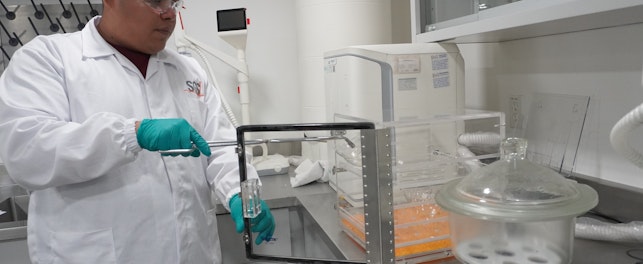On January 20, 2025, the European Commission banned bisphenol A (BPA), its salts and related hazardous bisphenols in food contact materials across the European Union (EU). This landmark regulation reflects the EU’s ongoing drive to strengthen restrictions on bisphenols.1 How can manufacturers and brands successfully navigate and comply with these latest prohibitions?
What are bisphenols?
Bisphenols are a group of industrial chemicals characterized by two hydroxyphenyl (-OH) groups linked by a carbon bridge, often a methylene (CH₂–) group. Their rigid aromatic structure provides high mechanical strength, heat and chemical resistance, electrical insulation and transparency, properties that make them especially valuable in the production of polycarbonate (PC) and epoxy resins.
First synthesized in 1891, BPA is the most commonly used bisphenol, with global production estimated at around 10 million metric tons annually.
Applications in the food contact materials industry
Bisphenols have been used in a wide variety of food contact applications, including:
- Internal coatings for metal cans and tubes (to prevent corrosion and contamination)
- Printing inks and adhesives used in food packaging
- Ion exchange membranes (used in water treatment for food and beverage processing)
- Sealing layers in ‘twist-off’ metal lids
- Storage equipment coatings, such as silos and tanks
- Chocolate molds and trays made from polycarbonate plastic
However, residues of free (unreacted) bisphenols can remain in the final material. Under heat, acidity or prolonged storage, these residues may migrate into food, creating potential safety risks.
Toxicological risks
Concerns over the estrogen-mimicking properties of certain bisphenols emerged in the 1930s, leading to their classification as endocrine-disrupting chemicals. By the 1980s, animal studies indicated metabolic and developmental effects from BPA exposure, and in the 1990s, it became clear that BPA could leach into food from contact materials. Subsequent research has linked exposure to reproductive toxicity, neurological impacts and other health concerns.
Risk assessment and safe exposure levels
Agencies such as the European Food Safety Authority (EFSA), German Federal Institute for Risk Assessment (BfR) and US Food and Drug Administration (FDA) set a tolerable daily intake (TDI) level for potentially harmful substances to protect public health. A TDI expresses the maximum amount of a substance (in mass per kilogram of body weight per day) that can be ingested daily over a lifetime without recognizable health risks.
In Europe, the EFSA has set a TDI for BPA of 0.2 ng/kg body weight/day. For an average adult, this equates to 12 ng of BPA per day. At this limit, if a food product such as canned tomato paste contains less than 1 µg/kg of BPA, the maximum safe consumption level would be around 12 g/day. However, if a foodstuff, for example, canned coconut cream, contains 54.7 µg, the safe intake level drops to about 0.22 g/day, underscoring the challenge for manufacturers.
Regulatory developments
Globally, although many jurisdictions now restrict BPA, the regulatory landscape is fragmented. For example, Canada and China have banned PC baby feeding bottles containing BPA, while Australia, Japan and New Zealand have encouraged voluntary removal.
In the US, the FDA permits BPA in certain food contact materials, including adhesives, coatings and polymers, but its use is prohibited in PC infant feeding bottles, sippy cups and epoxy-coated containers used for infant formula. Additionally, more than ten states and local jurisdictions, including California, Chicago, Nevada, Maine and Vermont, have enacted legislation to restrict BPA in food and beverage containers for use by children and adults.
Road to Regulation (EU) 2024/3190
In Europe, BPA was first identified as a substance of very high concern (SVHC) under REACH in 2017, following its classification as an endocrine disruptor and toxic to reproduction (category 1B).
In May 2023, the European Commission (EC) announced it was considering a ban on BPA in food contact materials and articles. Following a series of consultations, drafts and revisions, the draft ‘Bisphenol Regulation’ was adopted by the EC on December 19, 2024, and published as Regulation (EU) 2024/3190 on December 31, 2024.
Coming into effect on January 20, 2025, this regulation bans the use and trade of BPA, its salts and other hazardous bisphenols and their derivatives in food contact materials. It also amends Regulation (EU) 10/2011, which establishes safety requirements for plastic materials and articles intended to come into contact with food, and repeals Regulation (EU) 2018/213, which previously limited the use of BPA in food contact materials.
Regulation (EU) 2024/3190 has the following definitions:
- ‘Bisphenol’ – “a substance consisting of two hydroxyphenyl functional groups linked by one bridging atom, in accordance with structure A laid down in Annex I and includes the salt form of the bisphenol”
- ‘Bisphenol derivative’ – “a substance indicated by the general structure B laid down in Annex I, not including the salt form of a bisphenol”
- ‘Hazardous bisphenol or hazardous bisphenol derivative’ – “a bisphenol or a bisphenol derivative listed in Part 3 of Annex VI to Regulation (EC) No 1272/2008 due to its harmonized classification as category 1A or 1B ‘mutagenic’, ‘carcinogenic’, ‘toxic to reproduction’ or category 1 ‘endocrine disrupting for human health”2
It applies to a variety of materials, including:
- Adhesives
- Rubbers
- Ion-exchange resins
- Plastics
- Printing inks
- Silicones
- Varnishes and coatings
This means it will impact a wide variety of food contact articles, including metal can coatings, plastic drink bottles, water dispensers and kitchenware.3
Exemptions are limited and only apply when no safe alternative is available. These include the use of polysulfone resins in plastic filtration membranes essential for microbiological safety in certain foods, and surface coatings in large tanks and containers (> 1,000 liters) and associated large-capacity pipelines. In both cases, migration into food must be non-detectable.
Transition periods
While Regulation (EU) 2024/3190 imposes a broad ban on BPA and related substances in food contact materials, it provides phased timelines to allow manufacturers and businesses to adapt:
- Until July 20, 2026: brands may market BPA-based food contact articles that comply with previous legislation
- Until January 20, 2028: the following categories of food contact materials may continue to be placed on the market:
- Single-use food contact articles for the preservation of fruits, vegetables and fishery products
- Food contact articles where a BPA-based varnish or coating is applied only to the external surface of a metal substrate
- Until January 20, 2028: repeated-use food contact articles used as professional food production equipment may remain on the market.
- Until January 20, 2029: repeated-use food contact articles first placed on the market before July 20, 2026, can continue to be marketed
Industry response
Trade associations have responded critically to the adoption of Regulation (EU) 2024/3190. Chief among their complaints were an insufficient impact assessment, short transition periods and the lack of exemptions for certain critical applications (e.g. PC products such as foundry molds for chocolate and confectionery).
To ensure compliance with the new regulation, businesses must now:
- Identify all bisphenol derivatives used in products
- Conduct compliance testing (e.g. LC-MS/MS at 1 µg/kg detection limit)
- Prepare declarations of compliance
- Seek alternatives (e.g. non-bisphenol-based materials)
Beyond food contact materials
The versatility of BPA and other bisphenols has led to their widespread use well beyond food contact materials, appearing in products such as thermal paper, DVDs, electronics, medical supplies and synthetic fibers. While ingestion risks have made food contact materials the primary focus for regulation, attention is now shifting to other consumer products. For instance, recent studies have raised concerns over BPA residues in textiles and clothing.4
Regulatory action is already widening in scope. In Europe, BPA is restricted in thermal paper under REACH and 34 bisphenols are listed for prohibition in the new draft Toy Safety Regulation, which will replace Directive 2009/48/EC, the Toy Safety Directive.5,6
As our scientific knowledge of bisphenol-related risks grows, businesses should anticipate expanding restrictions across multiple sectors and prepare to adopt safe, compliant alternatives.
SGS solutions
We provide end-to-end support for manufacturers and brands in the food contact materials industry to ensure full compliance with global regulations around bisphenols. In addition to food contact material formulation reviews, we conduct compliance testing using an in-house developed methodology that incorporates state-of-the-art LC-MS/MS techniques. This covers multiple bisphenols and their derivatives, with detection limits down to 1 µg/kg, as well as other hazardous substances. Upon request, we can also test for other toxic bisphenols for complete peace of mind. Additionally, through root-cause analysis, we can help you identify possible sources of non-compliance for material improvement. In the end, it’s trusted because it’s tested.
Learn more about our food contact materials services.
IMPACT NOW for sustainability
Sustainability is in our DNA. Through our four IMPACT NOW for sustainability pillars – climate, nature, ESG Assurance and circularity – we offer innovative solutions that support smarter decisions, regulatory compliance and environmental responsibility. It is all part of our commitment to a climate-neutral, nature-positive and pollution-free future.
Discover our sustainability services and start making your IMPACT NOW.
Enjoyed this article?
Find more news and updates in our Consumer Compact newsletter >
Delivered direct to your inbox
Subscribe to Consumer Compact >
References
1EU prohibition on the use and trade of Bisphenol A from 20 January 2025
2Regulation EU 2024/3190 on the use of bisphenol A (BPA) and other bisphenols and bisphenol derivatives
3EU prohibition on the use and trade of Bisphenol A from 20 January 2025
4Concerns Raised Over PFAS and BPA in Clothing
5EU Regulates BPA in Thermal Paper under REACH (SGS SafeGuardS publication 115/25)
6EU Announces Compromise Text for Draft Toy Safety Regulation (SGS SafeGuardS publication 098/25)
© SGS Société Générale de Surveillance SA.
16th Floor, Block A, No.73 Fucheng Road, Century Yuhui Mansion,
Beijing, Haidian District, China





